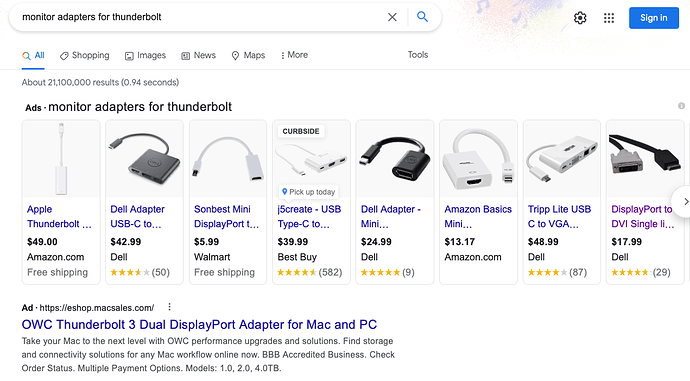More accurately, there are common ancestors. Since I love to write about history…
First there was DVI (April 1999), which Apple used extensively at the time. DVI tops out at slightly less than 4Gbit/s, supporting resolutions up to 1920x1200 at 60Hz (and higher resolutions at lower refresh rates). There is also a “dual link” version which uses twice as many wires to support a maximum bandwidth slightly less than 8Gbit/s. It supports resolutions up to 2560x1600 at 60Hz (and higher resolutions at lower refresh rates). Most notably, Apple’s 30" Cinema Display, with a native resolution of 2560x1600 requires dual-link DVI in order to support that resolution.
HDMI (December 2002), builds over DVI, adding features designed for consumer electronics support, including audio, HDCP encryption (which some DVI displays also support), device control, and even Ethernet data. Because it is based on DVI, a computer that provides single-link DVI video can drive an HDMI display with a simple adapter cable and a device that provides HDMI output can drive a single-link DVI display (video only - no audio or other HDMI features).
The original versions of HDMI support the same bandwidth (and therefore resolutions as single-link DVI. Later versions of HDMI (up to 2.1, introduced in 2017) support higher bandwidths up to 48 Gbit/s. This can drive a 5K display at 60 Hz or an 8K display at 30 Hz (or 8K at 60 Hz with data compression).
DisplayPort (May 2006) was introduced as a successor to VGA and DVI for computer monitors. The original version supports up to 8.6 Gbit/s (and can support 2560x1600 at 60Hz). Later versions (2.0 was released in 2019) support up to about 77 Gbit/s and can support 8K video at 85 Hz - which practically means it can support anything your computer and display can support.
Although DisplayPort is not compatible with DVI or HDMI signals, there is a dual mode variation, where a device can detect when the other end of the cable is DVI or HDMI and will fall back to a compatible mode. It’s been my experience that most computers with DIsplayPort interfaces include dual mode support. I don’t know how many displays have dual-mode ports, but it’s probably less important because quite a lot of DisplayPort displays include HDMI ports.
There are two standard DisplayPort connectors. The “full size” connector and a “mini” connector. Apple introduced the mini DP connector, but it can be found on computers and displays from many vendors.
Additionally, USB-C and Thunderbolt (all versions) support an “alternate mode” where you can use the connector to carry DisplayPort video to a display with a passive adapter cable.
Apple’s devices also support DVI/HDMI output via their mini DisplayPort, Thunderbolt and USB-C. They don’t document it as “DisplayPort dual mode”, but the results are pretty similar. They also offer relatively inexpensive adapters for VGA output over these ports - a feature that is definitely not part of the DisplayPort standard, but seems to be common on computers (not just from Apple).

